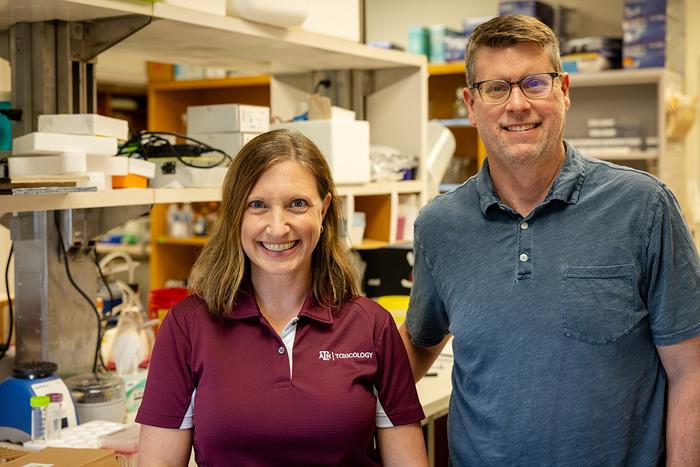The Texas A&M Center for Environmental Health (TiCER), a National Institute of Environmental Health Sciences (NIEHS) Environmental Health Sciences Core Center, will be returning to the Texas A&M School of Veterinary Medicine and Biomedical Sciences (VMBS) with a $7.6 million grant for the center’s new funding cycle.

Credit: Jason Nitsch/Texas A&M School of Veterinary Medicine and Biomedical Sciences
The Texas A&M Center for Environmental Health (TiCER), a National Institute of Environmental Health Sciences (NIEHS) Environmental Health Sciences Core Center, will be returning to the Texas A&M School of Veterinary Medicine and Biomedical Sciences (VMBS) with a $7.6 million grant for the center’s new funding cycle.
Under the new leadership of Dr. Weston Porter, a VMBS professor in the Department of Veterinary Physiology and Pharmacology, the center will promote research in four areas of environmental health — climate change and health, environment and metabolism, environmental justice and policy, and environmental stressors and their responses.
The center also will offer several tiers of research funding to encourage scientists to engage with community organizations, while also making funding more accessible for junior faculty.
“On the basic science side, we’re looking at tissues to see how chemicals found in the environment impact the body on a cellular level,” said Dr. Natalie Johnson, TiCER associate director and an associate professor in the Texas A&M Department of Environmental and Occupational Health. “On the community side, we’re looking at how exposures impact people and how we can advise them to stay safe.”
Core Centers like TiCER exist to facilitate collaboration between researchers across different scientific disciplines, even those whose main focus may not be environmental health. TiCER is one of only 26 Core Centers in the United States, and funding renewals are highly competitive.
Funding from the new grant cycle will support research projects in the center’s four major themes of environmental health, including small research vouchers and larger pilot grants intended to support large sections of a project.
“In addition to continuing support for current members of the center, one of our goals is to bring new people into the NIEHS and encourage them to apply for grants,” Porter said. “This is especially true for early-career scientists who may have new ideas worth trying but need resources to make them happen.”
The return of TiCER will also make Texas A&M one of the only universities — and the VMBS the only veterinary school in the nation — to house all three of the top NIEHS environmental health programs. These include grants supporting the Texas A&M Superfund Research Center and the Ruth L. Kirschstein Institutional National Research Service Award.
Research That Serves Texans
At TiCER, scientists are teaming up with community organizations to both share important health information and learn from Texans where they need to direct their research next.
“Working with the community is an essential part of how TiCER operates,” Johnson said. “The established way that basic science often gets translated to public health is one-directional — from ‘bench to bedside,’ or, from the lab bench to the hospital. But we want to interrupt that pattern so that people don’t have to go to the hospital in the first place. For us, research is from bench to the community and back.
“For example, in my own research, I look at how air pollution impacts the developing fetus. I ask questions like, ‘What does it mean for an infant’s immune system development when the mom breathes in pollution during pregnancy?’” she said. “It’s great to understand the science, but then we need to get the message back to the community, so people know what precautions to take, and work with them to understand how they are impacted.”
Having TiCER at the VMBS is ideal because of Texas A&M’s location in College Station, which is right in the center of the Texas Urban Triangle, a region that connects Houston, Dallas-Fort Worth, and San Antonio and Austin.
“Because we’re a state institution, it’s really part of our mission as faculty and researchers to reach as many Texans as possible. Our location will allow us to have access to some of the most heavily populated areas of Texas as well as rural communities in between,” Johnson said.
Opening Doors For New Research
One major goal for TiCER’s new leadership is to make sure junior faculty and those who have not worked with the NIEHS before feel like they, too, can participate in environmental health research.
“Once you get one grant to fund part of your research, it’s easier to get others that will help you continue,” Porter said. “But for junior faculty, it can be difficult to get that first project stage started. We hope that TiCER will help generate grants and make it more possible for early career scientists to get started. These grants will also benefit researchers at any point in their careers who have new ideas they want to test before applying for larger amounts.”
TiCER has multiple levels of grants, including pilot project awards for up to $50,000, as well as smaller vouchers that can award $1,000, $5,000, or $10,000. The different amounts allow TiCER to fund a variety of projects in different stages, whether researchers need to kickstart a small study or fund a major part of a larger project.
“We also help scientists look at their work from an environmental and public health angle to help them with funding,” Porter said. “By helping researchers make connections between the work they do and the impact it has on people’s health, we can make it more likely that they will get the funding they need to continue.”
For more information about TiCER, visit tx.ag/TiCER.
By Courtney Price, Texas A&M University School of Veterinary Medicine and Biomedical Sciences
###



